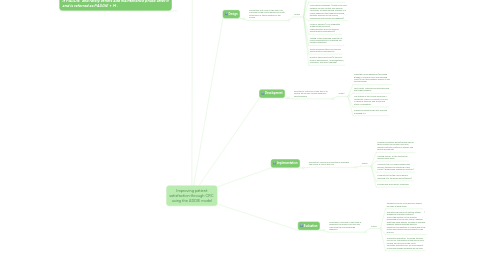
1. ADDIE model was first started in the 1970's and underwent over 20 revisions . Though known as a five step linear model some put planning before the analysis phase making it PADDIE and rarely others add maintenance phase after it and is referred as PADDIE + M .
2. Analysis
2.1. Description :Analysis of the training needs and training plan
2.1.1. Action
2.1.1.1. What is the identified knowledge gap? what is the needed change in behavior?(desired outcomes / course goals)
2.1.1.2. Who is the target audience/who should we recruit? ( the identified gap, language proficiency, level of experience, motivation)
2.1.1.3. Why is the training given, does it result in improvement the area of concern?
2.1.1.4. What resources are needed? (content,expertise, Delivery method (Social media, LMS, SMEs /Blog)
2.1.1.5. When will the course start and end? (the exact timeline for project completion )
2.1.1.6. Where will training be conducted ( work Place?home?)
3. Design
3.1. Description:Out come of this step is to, Overview of the course design and crate storyboard i.e. the foundation of the course
3.1.1. Action
3.1.1.1. Create the curriculum
3.1.1.2. Turning learning goals into learning/enabling objectives ( that have specific and measurable actions)
3.1.1.3. Create a storyboard/prototype of the ideas
3.1.1.4. Content:( determine topic to be covered and how much time is given to each topic, identify learning activities and exercises to be used
3.1.1.5. Instructional strategies : (create clear links between course content and learning objectives. Arrange learning activities in a logical sequence that supports learning, duration and pace of the course, assessment instruments and feedback).
3.1.1.6. Mode of Delivery:( LMS,integration Authoring environment, implementation plan and training administration requirements)
3.1.1.7. Testing of the Prototype evaluate if it meets requirements in achieving the learners objectives.
3.1.1.8. Define implementation and training administration requirements
3.1.1.9. Quantify the project cost (it terms of project development , implementation, evaluation and effort required)
4. Development
4.1. Description: Outcome of this step is to, Definie the course content guided by the storyboard
4.1.1. Action
4.1.1.1. Make the course appealing (by adding graphics, choosing color and deciding fonts) to suit the audience analysis in the analysis phase.
4.1.1.2. Test is with Materials and activities with the target audience
4.1.1.3. The testing of the course should be a systematic check of content for errors in spelling, grammar and syntax and utility of navigation.
4.1.1.4. Assess the length of the test and how engaging it is
5. Implementation
5.1. Description: outcome of this step is uploading The course is live on the LMS
5.1.1. Action
5.1.1.1. Prepare Facilitators guide/training manual that includes the course curriculum, learning outcome,Method of delivery and testing procedures
5.1.1.2. Training learner on the technology learning takes place
5.1.1.3. Upload to the LMS which handles the delivery tracking and reporting of the course ( grading and feedback collection)
5.1.1.4. Conduct pilot of the course before releasing it to the whole group(trainers)
5.1.1.5. Provide help and support as needed
6. Evaluation
6.1. Description: outcome of this stage is assessing the learner outcome and improving the course through feedback.
6.1.1. Action
6.1.1.1. Iterative and a go-no go decision should be made at each stage
6.1.1.2. Evaluation should be at multiple stages ( Kirkpatrick evaluation method). Survey the reaction of the learners embedded in the course, assess whether what they have learned resulted in changed behavior aligning with the learning objectives and whether it is applicable in the actual work area producing impacts in the long run
6.1.1.3. Summative evaluation to decide the Pass no Pass for certification at the end of each module, and the end of the curse. Formative evaluation will for improvement of learning through feedback will be used.

